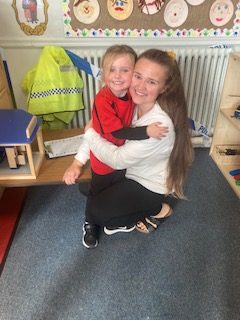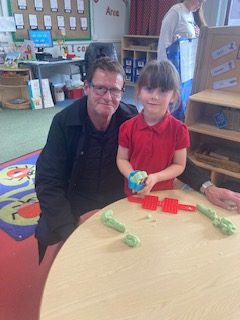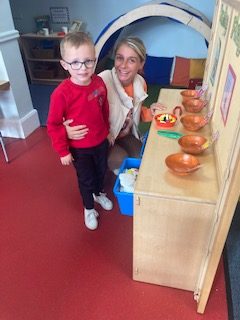Welcome to Reception
Read, Write, Inc letter formation rhymes
Number formation
Number rhyme cards
Things to do at home which help at school!
Communication, Language and Literacy
- One of the best things you can do is to join your child when they are playing. This article helps to explain how and why this can work: https://www.familylives.org.uk/advice/early-years-development/learning-and-play/why-play-matters/
- Games such as ‘I spy’
- Developing listening skills by reading different stories
Physical Development
- Joe Wicks
- Cosmic kids yoga
- A trip to the park/ bike ride/ scooter ride/ skipping
- Working with dough is really good for helping children to build strength in the smaller muscles in their hands. https://www.bbcgoodfood.com/howto/guide/playdough-recipe
Personal, Social and Emotional Development
- board games, where you practise taking turns (see below for a paper copy of snakes and ladders and guess who)
- snap or happy families
Literacy
- reading stories together
- https://www.teachyourmonstertoread.com/ Can be accessed for free using the website. There is also an app but there’s a charge for this.
- listening to an audio book
- writing your own story
- letter formation https://www.doorwayonline.org.uk/literacy/letterformation/ (You will need to access this site using a computer)
- Practise your phonics using flash cards (you can always make your own using paper and pens). This link will show you how to pronounce the sounds https://www.youtube.com/watch?v=TkXcabDUg7Q&list=RDCMUCo7fbLgY2oA_cFCIg9GdxtQ&index=1
- alphablocks from BBC iPlayer
Mathematics
- Numberblocks from BBC iPlayer
- board games
- Singing Walrus songs on YouTube
- jigsaw puzzles
- Early Years games on TopMarks https://www.topmarks.co.uk/Search.aspx?Subject=16&AgeGroup=1\
Understanding the World
This area involves guiding children to make sense of their physical world and community through opportunities to explore, observe and find out about people, places, technology and the environment. Some suggested ways you could explore these are:
- composting or making a wormery
- making a habitat for insects - you would only need a simple twig pile in the corner of your garden to make a start.
- Creating a physical family tree to display photos of your family on.
- building a den/fort where you can experiment with different types of light, such as torches or lamps
Expressive Arts and Design
- junk modelling - What can you create with your recycling? How can you decorate it and use it within your play?
- painting/ colouring
- singing/ dancing/ fancy dress
- There are a lot of creative ideas and activities for you to try on this link https://www.youtube.com/channel/UCtj7vv0GJ6DjUJYcMYQg1bw
Family board games
Welcome to Reception!
Class 1 - Mrs McAuley/ Mrs McCabe
Class 2 - Mrs Scott
Teaching assistants - Mrs Cummins and Mrs Wilson
Our Curriculum
There are seven areas of learning and development that must shape educational programmes in early years settings. All areas of learning and development are important and inter-connected. Three areas are particularly crucial for igniting children’s curiosity and enthusiasm for learning, and for building their capacity to learn, form relationships and thrive. These three areas, the prime areas, are:
- communication and language;
- physical development; and
- personal, social and emotional development.
Our PE lesson will be on a Wednesday. Children will need to come to school dressed in their PE kits. PE kit is a plain red T-shirt or school PE top and black shorts, leggings or tracksuit bottoms.
The specific areas are:
- literacy;
- mathematics;
- understanding the world; and
- expressive arts and design.
Educational programmes must involve activities and experiences for children, as follows.
Communication and language development involves giving children opportunities to experience a rich language environment; to develop their confidence and skills in expressing themselves; and to speak and listen in a range of situations.
Physical development involves providing opportunities for young children to be active and interactive; and to develop their co-ordination, control, and movement. Children must also be helped to understand the importance of physical activity, and to make healthy choices in relation to food.
Personal, social and emotional development involves helping children to develop a positive sense of themselves, and others; to form positive relationships and develop respect for others; to develop social skills and learn how to manage their feelings; to understand appropriate behaviour in groups; and to have confidence in their own abilities.
Literacy development involves encouraging children to link sounds and letters and to begin to read and write. Children must be given access to a wide range of reading materials (books, poems, and other written materials) to ignite their interest.
Mathematics involves providing children with opportunities to develop and improve their skills in counting, understanding and using numbers, calculating simple addition and subtraction problems; and to describe shapes, spaces, and measures.
Understanding the world involves guiding children to make sense of their physical world and their community through opportunities to explore, observe and find out about people, places, technology and the environment.
Expressive arts and design involves enabling children to explore and play with a wide range of media and materials, as well as providing opportunities and encouragement for sharing their thoughts, ideas and feelings through a variety of activities in art, music, movement, dance, role-play, and design and technology.
Each area of learning and development must be implemented through planned, purposeful play and through a mix of adult-led and child-initiated activity. Play is essential for children’s development, building their confidence as they learn to explore, to think about problems, and relate to others. Children learn by leading their own play, and by taking part in play which is guided by adults. There is an ongoing judgement to be made by practitioners about the balance between activities led by children, and activities led or guided by adults. As children grow older, and as their development allows, it is expected that the balance will gradually shift towards more activities led by adults, to help children prepare for more formal learning, ready for Year 1.
In planning and guiding children’s activities, practitioners must reflect on the different ways that children learn and reflect these in their practice. Three characteristics of effective teaching and learning are:
- playing and exploring - children investigate and experience things, and ‘have a go’;
- active learning - children concentrate and keep on trying if they encounter difficulties, and enjoy achievements; and
- creating and thinking critically - children have and develop their own ideas, make links between ideas, and develop strategies for doing things.




